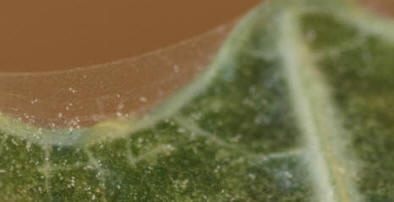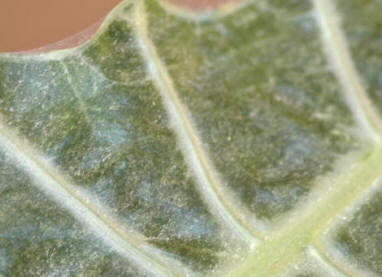Troublesome pest of many plants - particularly indoors or in greenhouse. Information and advice how to prevent and treat red spider mites.
The first thing that is normally noticed about red spider mite, is the damage that it is either doing - or has done!.
Red spider mites are so small, that they can only just bee seen - if looking - by the human eye. However, the damage done by these pests soon becomes apparent. The name is a bit of an anomaly - red spider mites are normally green in summer months!


If you click the image on the left, it will be enlarged enough to enable you to see Red Spider Mites. You will note that they are actually green here. See above. Easier to see, are the cobwebs which are often the first noticeable sign. of infestation
Red spider mites, are not actually spiders - even though they spin a web! They live from the sap drawn from plants by sucking at the underside of leaves. If left unchecked, they can do substantial damage to plants - even kill them.
Red spider mites are not easy to control - far better to try and prevent. Red Spider mite attacks a huge range plants - indoors and out. Indoor plants and greenhouse plants are normally worse affected, though Roses, other shrubs, some conifers - in particular Picea varieties - are also susceptible.
Symptoms. With indoor plants, the first signs are a general 'sick' look of the plant, with some mottling of the upper leaf surface. This generally happens before the webs or mites are noticed. Plants just stop growing, foliage takes on a discoloured look - pale - sometimes bronze.
Conifers tend to show sign of browning - as though scorched. This sometimes means that it is too late! Picea varieties - including the blue spruces, and also Picea albertina conica will show a general malaise that need prompt attention if you want to save your prize shrub from certain death by red spider mite.
Indoor plants - and greenhouse plants - will show a distinct discoloration of the leaf surface. In the greenhouse, Fuchsia leaves will start to look pale - maybe drop off. Same applies to a wide range of plants under cover. It may be necessary to view with magnifying glass to confirm the presence of red Spider.
Citrus fruit plants are very susceptible - especially in hot weather - indoors or outdoors.
Vegetable plots are not immune either - beans in particular are prey to the sap sucking mites. Strawberry plants also affected - with no usable spray treatment - bad news for Wimbledon!
Apple and Pear trees can also be affected - again a discolouration of the leaves - mottled, lightness, or even turning bronze/brown if unchecked.

Underside of affected
Alocasia houseplant © David Hughes
A closer look! © David Hughes
Likes and Dislikes : Red Spider mites prefer hot dry conditions. This is why they are particularly troublesome in the greenhouse - glasshouse. The same is also true outdoors on shrubs, Fruit Trees, perennials, vegetables and annuals in a hot dry summer. They dislike damp conditions - and certainly not too happy with cold either!
Prevention: Red spider is a difficult pest to eliminate once an infection has taken hold. This is in part due to the fact that they have several generations in the same infestation, and some chemicals will only kill certain stages of life cycle. Also, Red Spider Mites are capable of building up immunity to most chemicals available.
So! Prevention is obviously a major asset in the control of this troublesome pest. They do not like damp, humid conditions, together with which regular misting or spraying will actually suppress their ability to reproduce! (Similar to a cold shower?)
Regular spraying with fine mist of water, in greenhouse and also in hot conditions outdoors is a good form of defence. indoor plants perhaps best taken outdoors for this form of defence, though fine misting on a regular basis will certainly help to prevent a serious attack. Together with this, any form of increasing humidity levels around the house plant - other than for the general well being of houseplants - will help to reduce red spider infestation.
Cure: Difficult! but, sprays of bifenthrin, or malathion have proved successful. A single spray will not solve the prioblem, for reasons stated above ie only certain age groups within the population are affected.
Bifenthrin is found in brand names such as 'Sprayday', 'Bug Clear Gun', 'All-In-One Garden Pest Killer'
Provado Ultimate Bug Killer is also good - as are insecticide containing fatty Acids.
Maybe a rotation of these chemicals in extreme cases, to a/ prevent an immunity building up, and b/ also to combat the mites which have already built up resistance to one or the other of the sprays.
Biological control is a realistic method in enclosed situations such as greenhouses. The application is quite important - dependent on correct timing.
Main Page for Apple Tree Problems